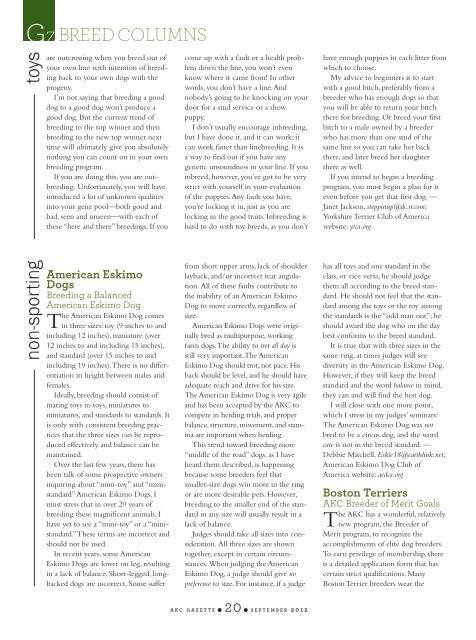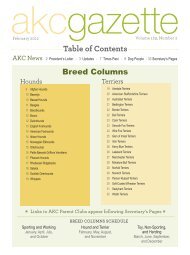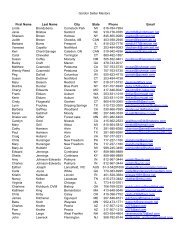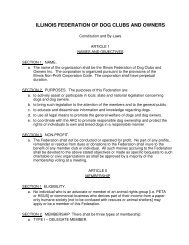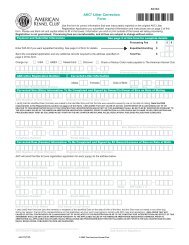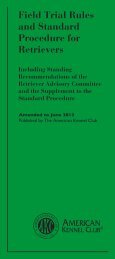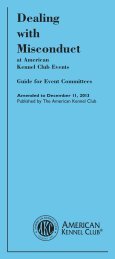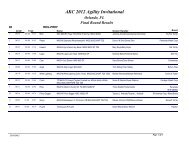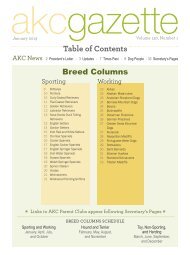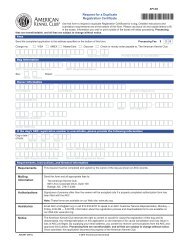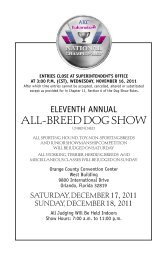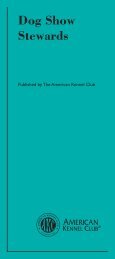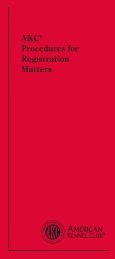Download - Parent Directory - American Kennel Club
Download - Parent Directory - American Kennel Club
Download - Parent Directory - American Kennel Club
- No tags were found...
You also want an ePaper? Increase the reach of your titles
YUMPU automatically turns print PDFs into web optimized ePapers that Google loves.
GZ BREED COLUMNStoysare outcrossing when you breed out ofyour own line with intention of breedingback to your own dogs with theprogeny.I’m not saying that breeding a gooddog to a good dog won’t produce agood dog. But the current trend ofbreeding to the top winner and thenbreeding to the new top winner nexttime will ultimately give you absolutelynothing you can count on in your ownbreeding program.If you are doing this, you are outbreeding.Unfortunately, you will haveintroduced a lot of unknown qualitiesinto your gene pool—both good andbad, seen and unseen—with each ofthese “here and there” breedings. If youcome up with a fault or a health problemdown the line, you won’t evenknow where it came from! In otherwords, you don’t have a line. Andnobody’s going to be knocking on yourdoor for a stud service or a showpuppy.I don’t usually encourage inbreeding,but I have done it, and it can work; itcan work faster than linebreeding. It isa way to find out if you have anygenetic unsoundness in your line. If youinbreed, however, you’ve got to be verystrict with yourself in your evaluationof the puppies. Any fault you have,you’re locking it in, just as you arelocking in the good traits. Inbreeding ishard to do with toy breeds, as you don’thave enough puppies in each litter fromwhich to choose.My advice to beginners is to startwith a good bitch, preferably from abreeder who has enough dogs so thatyou will be able to return your bitchthere for breeding. Or breed your firstbitch to a male owned by a breederwho has more than one stud of thesame line so you can take her backthere, and later breed her daughterthere as well.If you intend to begin a breedingprogram, you must begin a plan for iteven before you get that first dog. —Janet Jackson, steppinup@dc.rr.com;Yorkshire Terrier <strong>Club</strong> of Americawebsite: ytca.orgnon-sporting<strong>American</strong> EskimoDogsBreeding a Balanced<strong>American</strong> Eskimo DogThe <strong>American</strong> Eskimo Dog comesin three sizes: toy (9 inches to andincluding 12 inches), miniature (over12 inches to and including 15 inches),and standard (over 15 inches to andincluding 19 inches). There is no differentiationin height between males andfemales.Ideally, breeding should consist ofmating toys to toys, miniatures tominiatures, and standards to standards. Itis only with consistent breeding practicesthat the three sizes can be reproducedeffectively and balance can bemaintained.Over the last few years, there hasbeen talk of some prospective ownersinquiring about “mini-toy” and “ministandard”<strong>American</strong> Eskimo Dogs. Imust stress that in over 20 years ofbreeding these magnificent animals, Ihave yet to see a “mini-toy” or a “ministandard.”These terms are incorrect andshould not be used.In recent years, some <strong>American</strong>Eskimo Dogs are lower on leg, resultingin a lack of balance. Short-legged, longbackeddogs are incorrect. Some sufferfrom short upper arms, lack of shoulderlayback, and/or incorrect rear angulation.All of these faults contribute tothe inability of an <strong>American</strong> EskimoDog to move correctly, regardless ofsize.<strong>American</strong> Eskimo Dogs were originallybred as multipurpose, workingfarm dogs. The ability to trot all day isstill very important. The <strong>American</strong>Eskimo Dog should trot, not pace. Hisback should be level, and he should haveadequate reach and drive for his size.The <strong>American</strong> Eskimo Dog is very agileand has been accepted by the AKC tocompete in herding trials, and properbalance, structure, movement, and staminaare important when herding.This trend toward breeding more“middle of the road” dogs, as I haveheard them described, is happeningbecause some breeders feel thatsmaller-size dogs win more in the ringor are more desirable pets. However,breeding to the smaller end of the standardin any size will usually result in alack of balance.Judges should take all sizes into consideration.All three sizes are showntogether, except in certain circumstances.When judging the <strong>American</strong>Eskimo Dog, a judge should give nopreference to size. For instance, if a judgehas all toys and one standard in theclass, or vice versa, he should judgethem all according to the breed standard.He should not feel that the standardamong the toys or the toy amongthe standards is the “odd man out”; heshould award the dog who on the daybest conforms to the breed standard.It is true that with three sizes in thesame ring, at times judges will seediversity in the <strong>American</strong> Eskimo Dog.However, if they will keep the breedstandard and the word balance in mind,they can and will find the best dog.I will close with one more point,which I stress in my judges’ seminars:The <strong>American</strong> Eskimo Dog was notbred to be a circus dog, and the wordcute is not in the breed standard. —Debbie Mitchell, Eskie18@earthlink.net;<strong>American</strong> Eskimo Dog <strong>Club</strong> ofAmerica website: aedca.orgBoston TerriersAKC Breeder of Merit GoalsThe AKC has a wonderful, relativelynew program, the Breeder ofMerit program, to recognize theaccomplishments of elite dog breeders.To earn privilege of membership, thereis a detailed application form that hascertain strict qualifications. ManyBoston Terrier breeders wear theA K C G A Z E T T E • 20 • S E P T E M B E R 2 0 1 2


